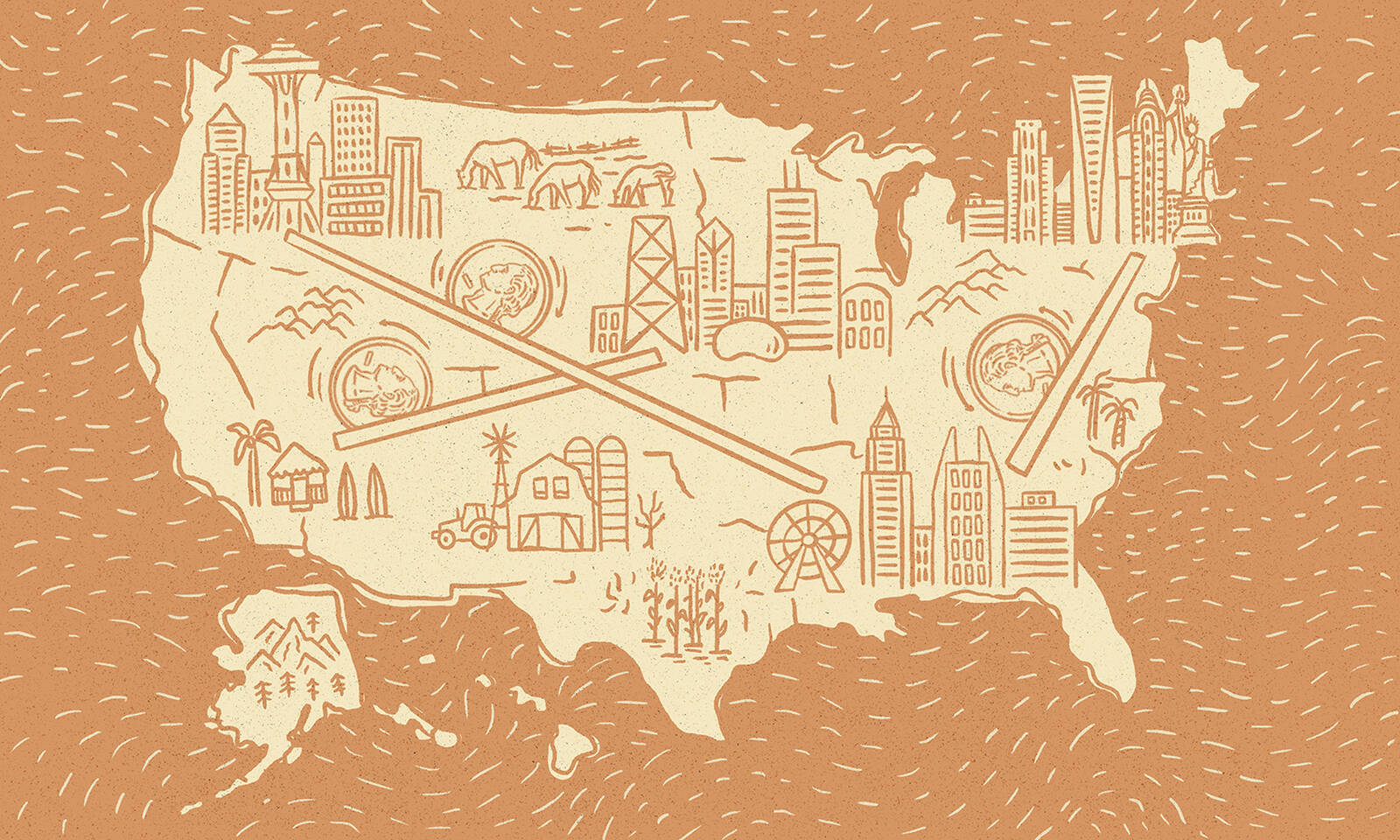Featured Faculty
Gaylord Freeman Distinguished Chair in Banking; Professor of Finance; Finance Department Chair

When you talk to Richard Sandor about his history as a serial entrepreneur in financial markets, it cannot be a short conversation.
Over the past half century, Sandor has been prescient and present at key moments in the creation and evolution of financial futures contracts, catastrophe insurance, and a climate exchange. Most recently, he has developed a new interbank lending market, the American Financial Exchange, which gave rise to a new interest rate index, AMERIBOR.
Sandor has several times been at the right place at the right time with the right idea. But how? After all, with markets you have to be early to be on time. As Sandor puts it, “You have to make a ten-year bet before you can launch a market and expect it to be productive. You have to really be able to identify what you think is a major change in an ecosystem ten years out.”
Sandor’s latest venture, AMERIBOR, evolved in the wake of the LIBOR scandal.
Over the decades, LIBOR—a survey-based measure of the average interest rate at which 16 global banks lend to one another, unsecured, for three months—has become deeply embedded in our financial system, serving as a primary benchmark for interest rates. But it has a deep, underlying flaw: it relies on the banks to self-report their own borrowing rates—for loans that typically don’t actually exist. This made LIBOR ripe for rate-rigging. Around 2012, LIBOR manipulation became public knowledge, and over the next few years, billions of dollars of fines would be levied against Barclays, UBS, Royal Bank of Scotland, Citigroup, JPMorgan Chase, Deutsche Bank, and others.
In 2021, the much-beleaguered LIBOR is slated to be retired, paving the way for alternative benchmarks like AMERIBOR to gain traction. So how has Sandor, once again, found himself in the right place at the right time, poised to benefit from changing headwinds?
Sandor—who taught Kellogg’s first course on futures and options in 1974, just before the first interest rate futures contract was introduced—recently sat down with Bob McDonald, a professor of finance at Kellogg. The pair discussed what led Sandor to develop AMERIBOR, as well as how he sees interest rate benchmarks evolving in a post-LIBOR world. Here is an excerpt of that conversation, edited for length and clarity.
McDonald: In 1975 you helped to introduce a market for interest rate futures. Now we are here to talk about a new interest rate contract that you have created: AMERIBOR. How did you become interested in developing this market?
Sandor: In 2011, after we developed market-based tools to address acid rain and global warming, we were going to develop water markets. But then I read that a major bank fired traders for manipulating LIBOR. So, I figured if one bank did it, two must have, and then it’s a binomial expansion. Right? I realized that ultimately the structure of LIBOR was flawed.
LIBOR wasn’t transactionally based; it was a poll. And that’s like electing the president of the United States based on the Wall Street Journal–ABC poll of who’s going to win.
And so I figured we had to invent a new thing.
McDonald: What’s interesting is that a lot of people saw a problem in how LIBOR was constructed. But you foresaw that the market would likely change, and there would be a need for a different benchmark. You were trying to look past the current environment to decide what was sustainable and what wasn’t.

Sandor: And as with interest rate futures, everybody thought a new thing was unnecessary. And it was exacerbated by the fact that, once again, interest rates were zero. Everybody said, “there’s no fed funds market—it died in ’07, ’08. This will never work.”
McDonald: Banks used to actually borrow and lend to each other. But during the crisis, the big banks with direct access just started borrowing and lending directly with the Fed. By 2011, most of the fed funds traders who managed those interbank loans were gone.
Sandor: Right, and I said, “Well, being in a deep sleep doesn’t mean the fed fund market can’t be revived if interest rates move off zero.”
Then, in 2014, the Fed said, “LIBOR needs a replacement.” So, all of a sudden, the skies became friendlier. And as 2015 moved along, we partnered with CBOE: we would develop the AMERIBOR brand; they would list futures, options, ETFs, things of that nature, on a regulated platform. We finalized the deal in July, and a few months later, interest rates moved off zero.
So it came down to timing. We could never start an exchange now—in 2020. It had to be up and running before the pressure to replace LIBOR peaked.
We launched on December 11, 2015 with four banks who traded. And we went from those four credit lines to over 1,400 today, and we created nearly 50 billion dollars of new credit in the interbank market and reestablished the fed funds market.
“Regional, midsize, and community banks borrow unsecured. This gives AMERIBOR an advantage, because it creates assets that are correlated to their own borrowing cost.”
— Richard Sandor
McDonald: I think what probably surprises people about AMERIBOR the first time they hear about it is how you calculate the rate. Instead of going with the rate at which big players can borrow money, you’re basing the number on actual transactions done among midsized, regional and community banks. So could you talk a little bit about that?
Sandor: Yes. We went to Tupelo, Mississippi; Bentonville, Arkansas; and San Antonio, Texas. We found out where the best barbecue joints in America are!
In my experience in new markets, the first movers are never the biggest companies. So the first users of Ginnie Mae futures were mortgage bankers in Alabama, not the big New York firms. In the case of bonds, it was regional brokerage firms, small brokerage firms; it wasn’t Salomon Brothers.
So, in order to get geographic representation and a significant number of traders, and to identify first movers, it was richer to go for medium-sized banks.
McDonald: What was your pitch? Are you essentially going to these medium-sized banks and saying, “The world that you’re living in is not going to exist in the future. We’d like your help in getting an alternative off the ground that will enable you to deal directly with one another?” Were you arguing that there was an advantage in not having to deal with the bigger banks?
Sandor: Yes. The advantage was to create a peer-to-peer fintech that allowed you to source liquidity from each other. And the premise was it was going to be cheaper peer-to-peer because there were reserves lying around in Boston, and there was a need for liquidity in Alabama.
We recognized that some regions that were growing quickly would have a demand for liquidity, while other regions that were growing slowly would have excess liquidity. (This is no different than the housing demand being in Arizona, California, and Nevada, but all of the money being in the New England savings banks.)
McDonald: I am interested in your thoughts about the transition away from LIBOR, and the specific role that AMERIBOR might play in this. I looked at the data: there’s something like $450 trillion dollars of notional interest rate products out there, many of which are based on LIBOR. This number is mind-bogglingly large.
“AMERIBOR is highly correlated with the old LIBOR and the least volatile of interest rate benchmarks. And what we aim to be is the most boring benchmark in America.”
— Richard Sandor
Sandor: Yes, it is mind-boggling. Part of the challenge is to implement an alternative to LIBOR going forward. The alternative could be AMERIBOR, or it could be something else.
We will have to educate banks to start using AMERIBOR to price commercial loans and ultimately other kinds of assets: credit cards, auto loans, mortgages. But it shouldn’t be complex to do because LIBOR and AMERIBOR are highly correlated, and I mean 98–99 percent. So the education problem is not that severe. We are also already seeing interest from insurance companies, corporations, and money managers in using AMERIBOR.
McDonald: So AMERIBOR is more highly correlated with LIBOR than is SOFR [an alternative benchmark published by the New York Federal Reserve that is based on banks’ overnight borrowing costs for loans that are secured by government bonds].
Sandor: That’s correct. Now, SOFR is excellent for large banks that own government securities. But for our regional, midsize, and community banks, their lack of familiarity with that market makes the transition to AMERIBOR easier.
McDonald: It seemed to me that SOFR is closer to a pure risk-free rate, since it is secured by government bonds.
Sandor: Yes. But the regional, midsize, and community banks borrow unsecured. This gives AMERIBOR an advantage, because it creates assets that are correlated to their own borrowing cost.
McDonald: This allows them to hedge their own exposure to risk. So, if AMERIBOR and SOFR had both been in existence during the flight to quality in 2007, 2008—when investors shifted their capital away from riskier investments and toward safer ones—you believe SOFR would have fallen, while AMERIBOR would have better matched the funding rates.
I suppose AMERIBOR also has the advantage of not being tied to the availability of government securities. Because if there is a sudden dip in supply, or hike in demand, then SOFR is going to potentially jump around.

Sandor: Yes, and that’s in fact what happened in September 2019 when technical issues caused SOFR to surge, while AMERIBOR stayed relatively steady. AMERIBOR is highly correlated with the old LIBOR and the least volatile of interest rate benchmarks. And what we aim to be is the most boring benchmark in America.
Let me switch to a thornier challenge: LIBOR will theoretically come to an end at 2021. So what happens to all of the contracts post 2021?
McDonald: What do you think everything’s going to look like five years from now?
Sandor: LIBOR was unique in that it became ubiquitous and people just adopted it. I think the world in five years will have choice. You’ve got different kinds of crude oil, you’ve got three kinds of wheat futures (pasta, bread, and cookies), and you’ve got more equity indexes than you have equities (Dow Jones, S&P, Nasdaq, Russell Value Line, large cap, small cap, intermediate cap). There’s a proliferation of choice.
The big banks, government agencies, and multinationals will likely choose a risk-free rate. Some market participants will choose AMERIBOR, others will choose something else.
McDonald: And that would just be reflecting the fact that different institutions have different needs. Any final thoughts?
Sandor: Up to 450 trillion dollars of instruments have to be repriced. These numbers are daunting. But I believe firmly that they’re less of a challenge than people think. It’s just like the fear that existed in 1999 around Y2K: “We’re going to hit the millennium; the world’s going to stop and the sky is falling!” And then all of a sudden you pass that date, and nothing happens.
I think our financial system is more adaptive than people currently believe. It’s a bad idea to bet against the flexibility of our financial sector to manage something like this.